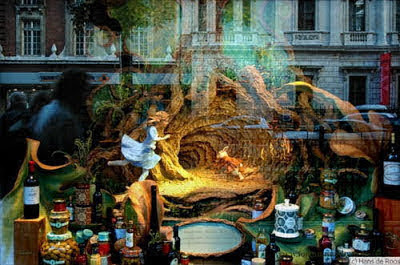"How to Remember You're Alive"
by David Cain
"One way to appreciate virtually any moment of your life is to pretend that the whole thing is already over. Your life came and went a long time ago, but for some reason you’ve just been sent back to this random moment, here in this office chair, or in line at Home Depot.
It isn’t clear why you’ve been sent back. Maybe it was a cosmic accounting error, or a boon from a playful God. All you know is that you’re here again, walking the earth, having been inexplicably returned to the temporary and mysterious state of Being Alive.
Any moment will do for this experiment. In fact, the more mundane the moment, the more profound the effect. You might find yourself, in this instance, pushing a cart through the frozen foods aisle. Or maybe you’re seated in front of a bowl of cereal at the speckled Formica breakfast table you bought on Craigslist. Or you’re carrying a bag of recycling down the back stairwell on a muggy night. It’s definitely your life though, and at least for now, you get to be alive again.
When you view life as something you’re returning to — rather than something that has never not been happening — it feels like the gift it perhaps always should. It’s just so damn interesting to be alive and experiencing things, and choosing what to do during those experiences.
Seeing life as the curious and rare condition it is gives even ordinary events the character of a brilliant film. An oblong rectangle of sunlight on the table flutters with the shadows of leaves. While you fold laundry, your phone lights up: a friend texting you a cheesy pun she knows you will appreciate. A short-lived party of bubbles appears and disappears when you fill a glass of water from the tap. A thin mist pours from the open freezer display onto your sandaled feet. It’s all spectacular, just because it’s happening, and once it’s over you would greatly miss it if you could. So why not miss it now? Or at least understand why you would.
The state of Being Alive also comes with a rich and distinct sense of possibility. You can make any number of interesting things happen by sheer will. You can scrawl sentences on a scrap of paper that will trigger certain thoughts later, for you or someone else. You can touch a few buttons on your phone and be speaking to any of a hundred people you know, and whatever is said would change each other’s day, or life, in some way. You could clean the house this afternoon, or leave it messy, and each option would give a different shape to the evening.
Can you believe that this condition – of being in the world, of feeling stuff and doing stuff - was once happening all the time? Remember being able to open windows and pet dogs and wash your hands in warm water? What an amazing time that was. No matter what happened, whether life was decidedly going “well” or not, it was always so eventful, and you got to decide what to do in each moment of it.
It’s all over, of course, which is too bad. You didn’t realize at the time how small a window it was, and you can’t believe you spent a lot of it complaining. However, for right now at least, for some reason, you’re back. You have at least this moment to enjoy being alive. There may be more coming afterward, but you can’t count on that. Not this time anyway.
Except in moments of extreme emotional tilt, this exercise always seems to work. I can almost always, when I think of it, choose to see the current moment as a certain kind of an unexpected gift - a long-awaited return to the most interesting thing ever, which is being alive.
It works because if it were true - you really had just been sent back to the realm of the living - chances are you really would think it’s unutterably great to be here, even if you didn’t the first time. By mentally jumping out of life and then back in, it becomes clear that the experience of being alive really is a profoundly interesting thing, and we can live with an ongoing awareness of that. That few seconds of contemplation reframes virtually any moment as the best thing that can happen: you, enjoying a rich pocket of Being Alive Right Now, amidst a vast universe that is almost entirely not that.
At least, it becomes interesting when you’re aware that there’s no reason any of this should necessarily be the case. There will not always be things happening. You will not always have the ability to experience the world and respond how you please. But - by the grace of whoever - you do right now. Whatever the metaphysics of it really is, the point is that the window is small, and if you’re in it right now, that should probably be regarded as a profoundly lucky thing, whether it’s your first time here or you’ve been sent back for another tour.
However, because the window is open continuously until it’s closed for good, it’s hard to feel the luckiness of being alive while life is still happening. This is one way to contact that sense of good fortune reliably - see the moment as an inexplicable return to the wild and spectacular condition of Being Alive, which was once so abundant you forgot to appreciate it. This experience you’re having right now, of being here in a body, experiencing the world and choosing how to respond - is gone, and by the Law of Joni Mitchell, you only now know what you had. But by some unbelievable stroke of luck, here it is again."


































